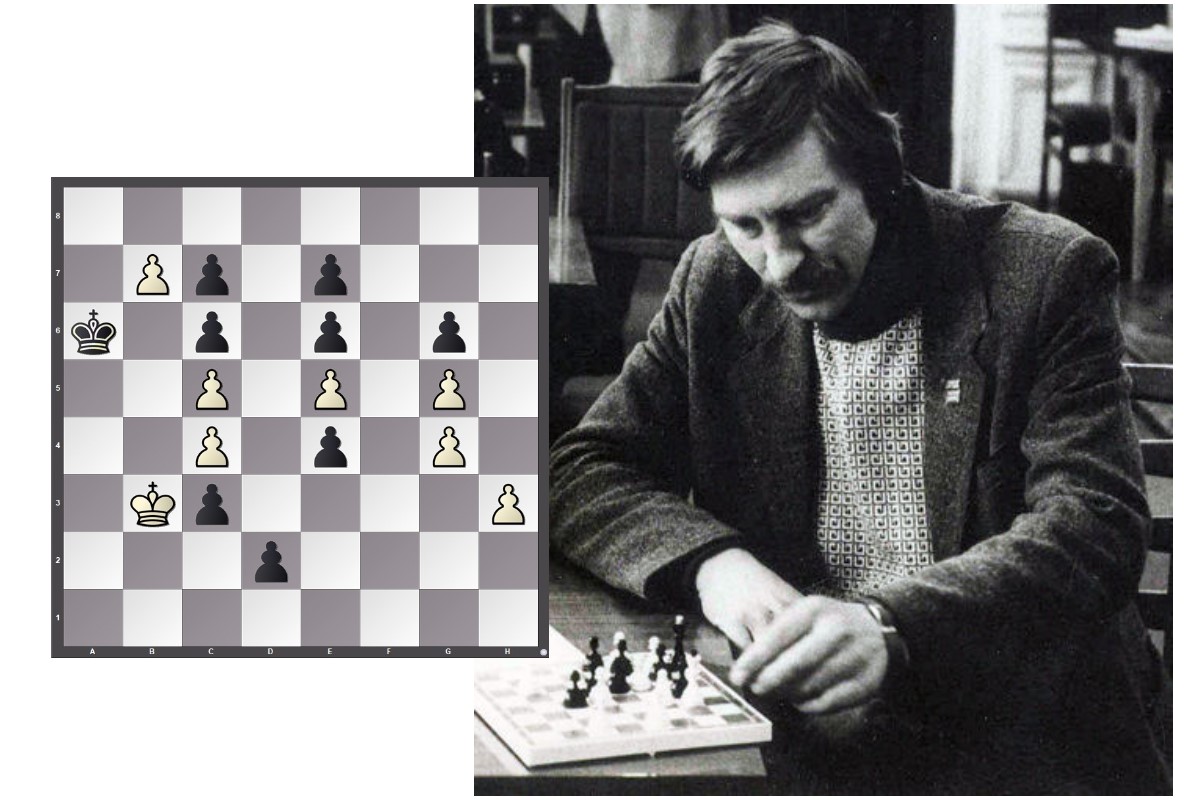


Although many other endgame study composers created pawn endgames, two were outstanding. I wrote an extensive article on Nikolay Grigoriev in April 2018, based on the research of Sergey N. Tkachenko. The same researcher’s writing also provides valuable insight into the life of the other pawn-endgame master, Mikhail Zinar.
There are small joys that I look forward to when receiving magazines, and one of those joys was to browse for endgame studies by Mikhail Zinar. His ever-interesting ideas, his incredible mastery of pawn endgames, and his ease to create task problems (we will look at those next month) made his endgame studies always worth replaying in my head. Sometimes it would just be a slight smile at recognizing a familiar idea, sometimes it would be astonishment at an outrageous construction (in the good sense of the words).
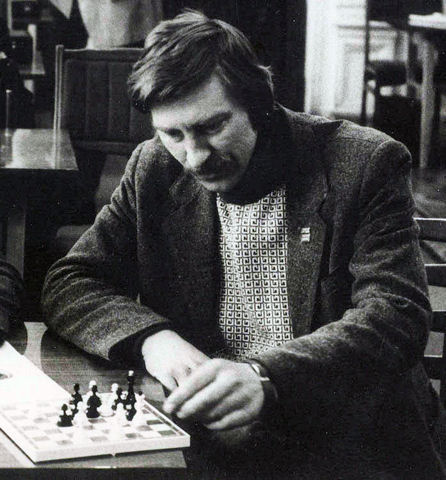 Born on 22 November 1950 (another often mentioned birthdate was 9 May 1951 — we will get to that below), Mikhail Zinar passed away on 4 February 2021.
Born on 22 November 1950 (another often mentioned birthdate was 9 May 1951 — we will get to that below), Mikhail Zinar passed away on 4 February 2021.
Databases are a wonderful thing. I browsed the endgame-study database many years ago, when I noticed that there is someone who created pawn endgames almost exclusively. “Zinar”. I had never heard of that person. But his endgames are incredible. It seemed very sad that this talented man had disappeared around 1990. At least that was when his composing career stopped. Curiosity took over. I inquired about Zinar’s career in 2007, when Sergiy Didukh provided additional information, including that Zinar, after moving from Crimea to Ukraine, had died prematurely. Yet, just a week later, on 6 August 2007, Didukh confirmed that Zinar was still alive and working in a school. From what I understood, Zinar simply did not have the money to send in his originals. More details on this are given at the end of this article.
Sergey N. Tkachenko, not only a great researcher but also a great writer, published an article about Zinar afterwards, titled “The king of chess pawns”. More information taken from this article is given below (I translated it for my understanding with DeepL). The original article is only available in Russian, although later Tkachenko wrote a book in English about Zinar — “Mikhail Zinar’s Difficult Pawn Endings” — but I don’t own it.
Set on the background of the Cold War, Zinar’s parents tried to postpone the enlistment of young Mikhail to the military as long as possible, and thus they gave a wrong date of birth for his passport. As such, Zinar’s passport says he was born on 9 May 1951, while in reality he was born on 22 November 1950. The early 1960s conflicts that led to this decision that apparently must have been done in Zinar’s teen years are given by Tkachenko in his article, including the 1962 Cuban Missile Crisis that nearly led to a global thermonuclear war. After the military tensions cooled down, Zinar had to keep the wrong date of birth, as his parents otherwise could have been convicted of a crime.
Gvozdavka-1, around 250 kilometers north of Odessa, saw horrors during World War II, evidence of which was found only in 2007. Zinar spent his childhood in that village, possibly unaware of what happened less than a decade prior to his birth. It was later known that the close town of Gvozdavka-2, separated from Gvozdavka-1 by the Kodyma river, was the site of a concentration camp.
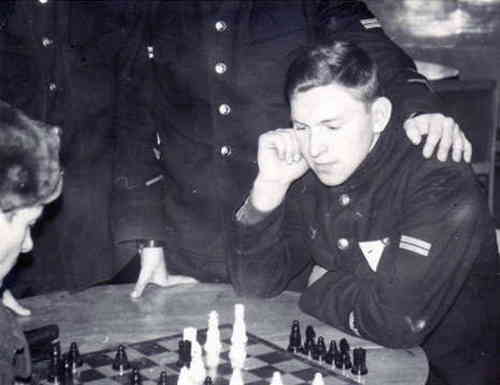
The time when Zinar finished school was also the time of the moon race. In 1957, Russia sent the first female to space — young dog Layka. In 1961, Yuri Gagarin flew into outer space, or to the cosmos, as it is called in Ukraine and the Soviet Union. After his only spaceflight, Gagarin was revered as a hero, and when Zinar finished school in the year of Gagarin’s death, 1968, the lifelong passion for aviation and spaceflight turned real: Mikhail Zinar applied for the Kiev Civil Aviation Flying School. Medical issues prevented him from joining, however. So, he applied to a similar school in Egorievsk near Moscow, hoping for his issues to be resolvable when the training was finished there. This worked out partially, as Zinar’s condition improved after the three years of training and two years of groundwork at the Simferopol airport. However, something happened that made Zinar pursue another dream...
Yuri Gagarin Recreation and Culture Park in Simferopol was a place that was attended by many people, and one day, when Zinar strolled around, he got near a chess pavillon where he found a new passion...
130 rubles, dormitory accommodation. A technician-mechanic had a good salary. After all, the life of hundreds, thousands, millions of people depend on the unsung heroes on the ground who make sure that those massive constructions work flawlessly, transporting people and cargo through the air. From a salary point of view, Zinar was fine. But his newfound passion prompted him to make a huge sacrifice.
90 rubles, no accommodation. Trainer at a youth sports school. Where to sleep? At the workplace, after the last visitors left. Zinar did his work, then slept there — now nearly his entire life was chess. He was a man who chased his dream, even thought it meant sacrificing material goods, sacrificing the comfort of owning a dorm room, but also giving up the responsibility of having in his hands the survival of others. We don’t know if this was also part of his decision, but we could imagine that not everyone would want to face a life-or-death situation (for others) every day, even if it is more abstract than for a medical doctor or a firefighter.
Tkachenko writes about Zinar’s sleeping habits:
Having closed the doors behind the last visitor of the chess club, Zinar moved tables, took a mattress with bedclothes out of the closet and settled down for the night. In the morning the whole procedure was done in the reverse order...
The same year in which he changed his workplace, Zinar published his first endgame study (please note that all endgame studies presented can be replayed below).
This is a case of “corresponding squares” — squares opposed to each other but not in an obvious way. However, the “battering ram” formation for pawns is used, as it is called in German (“Widder”). So the approach is similar, but not exactly the same as for the “battering ram”, depicted on the following diagram:
While in Zinar’s study c5 is blocked, the weakness of the pawn on d6 makes up for it, forcing Black to go to e3 if White goes to b5. With that and additional considerations on how the kings must be placed earlier during each step of the solution, the unfolding play is easy to understand: 1.Kc2 Kf7 2.Kb2! Kg6 3.Ka3! Kf6 4.Kb3! Kf5 5.Kb4! Kf4!
Mutual zugzwang dictates everything. White had to reach this position with White to play, so the position prior to this move was a mutual zugzwang. The previous moves avoided the reverse to happen — 6.Kb5 Ke3 7.Kc4 Kf3 8.K:d4 Kf4 9.Kc3!, and White wins
Already with the first study, Zinar showed the world that he can create great pawn endgame studies, in the style of Nikolay Grigoriev.
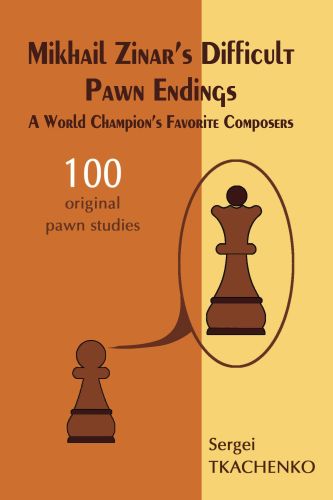 Tkachenko gives background information on how Zinar got to composing endgame studies: Yuri Averbakh, now 99 years old, had published his “Шахматных окончания” (“Chess endings”; later compiled in English as the five-volume book “Comprehensive Chess Endings”) in 1956, spanning various books. One of the volumes of the book series was bought by Zinar from a second-hand bookshop. Ilya Maizelis had written the section about pawn endings, and Zinar became interested in the diagrams with numbers denoting the corresponding squares. Talented in mathematics, Zinar noted that the theoretical evaluation was incomplete. He decided to improve on it — interestingly, this eventually led to him becoming the editor for pawn endings in Averbakh’s “Chess endings” from 1983 (in Russian). Averbakh mentions in the preface that Zinar at first didn’t know that he had created endgame studies and only thought he filled gaps in endgame-theory knowledge.
Tkachenko gives background information on how Zinar got to composing endgame studies: Yuri Averbakh, now 99 years old, had published his “Шахматных окончания” (“Chess endings”; later compiled in English as the five-volume book “Comprehensive Chess Endings”) in 1956, spanning various books. One of the volumes of the book series was bought by Zinar from a second-hand bookshop. Ilya Maizelis had written the section about pawn endings, and Zinar became interested in the diagrams with numbers denoting the corresponding squares. Talented in mathematics, Zinar noted that the theoretical evaluation was incomplete. He decided to improve on it — interestingly, this eventually led to him becoming the editor for pawn endings in Averbakh’s “Chess endings” from 1983 (in Russian). Averbakh mentions in the preface that Zinar at first didn’t know that he had created endgame studies and only thought he filled gaps in endgame-theory knowledge.
Tkachenko describes how chess grew in the 1970s and led to a chess club being founded in Feodossia in the early 1980s, to which Zinar was invited to become the director. This greatly benefited Zinar’s work, as Vladimir Archakov learnt of Zinar. Archakov not only worked on over a dozen of chess columns but also was a civil aviation pilot, the same occupation that Zinar once had dreamt of taking.
Kiev was officially founded in 482. Now it was 1982. Vladimir Archakov celebrated this with a Kiev 1500 Anniversary Tourney for endgame studies. More than 80 endgame studies were submitted by the highest masters — Dolgov, Nadareishvili, Pogosyants and many more. There is even one “Kievsky” in the database, but his composition is from ten years later — we don’t know if his last name stems from the city. We, however, do know that 15 different compositions were selected for the award. The winners were a study by Leopold Mitrofanov (later found to be incorrect by Hörning/Josten) and a six-piece pawn endgame study (see the replayable solution below). The pawn study, as Tkachenko writes, “became the hallmark of the competition”.
Zinar gained widespread recognition after this, as he also received his first title. The 16th USSR Chess Composition Championship 1981-1982 saw the above endgame study at the 5th to 12th place, but Zinar received the master title, skipping the candidate title. I am not sure what Tkachenko exactly refers to, possibly it is the Master of Sports title.
Of course, the study above was published shortly after one of my absolute favuorites (and of course the word absolute is necessary, as many Zinar studies are among my favourites) and you can see it in the replayable board below. For players who want to spend some time figuring out the solution, the diagram is given here.
Five pieces. A pawn endgame. It will — that much shall be given as a hint — not turn into a complicated queen endgame. And yet, I believe that it is not entirely trivial to win.
In the 1980s Zinar started to compose multi-phase pawn endgames, i.e. a position arises in which there is play after the promotions. All seemed well for Zinar, but then something happened. In 1990, eight endgame studies by Zinar were published, and the master suddenly disappeared completely...
So let us circle back to the beginning. It was 30 July 2007. I had learnt about Zinar, about his brilliant endgame studies, his many pawn endgames with or without promotion ideas, as well as a few attempts at tasks. The Soviet Union had been dissolved on 26 December 1991. The German Democratic Republic had joined the Federal Republic of Germany on 3 October 1990. Zinar seemingly had disappeared during times of great political changes. But those changes might have meant a lot of different things: Did he disappear for political reasons? Did he assume a new identity? Or...did something really bad happen?
I asked on MatPlus, the forum based on the magazine by Milan Velimirović. The forum had been founded just the previous year but already saw many chess composers from all around the world. Our small world was united — Western and Eastern composers communicated.
Just a day later, Sergiy Didukh provided the information that he had found:
In 1995 Mikhail Afanasievich Zinar moved from Crimea to a little village, Gvozdavka-2, in the Odessa region (300km from Odessa). He taught labour discipline at school. In 1997 S. N. Tkachenko came to see him and M. Zinar told him that he had abandoned composition because of financial difficulties. Those were really hard times for Ukrainian people and especially for teachers. They were paid 10-20 dollars a month.
A little later M.Zinar prematurely died.
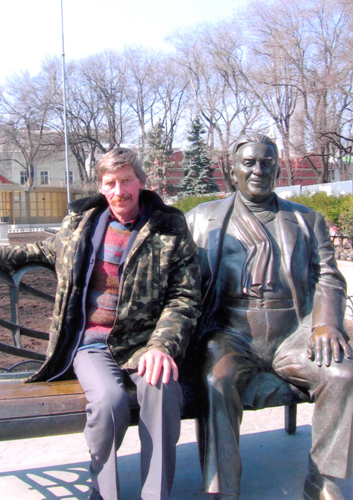 The riddle seemed to have been solved — it was not unexpected but still was very sad. Yet nothing accounted for five years without publications. Sergiy Didukh must not have been satisfied with what he had found and continued his research. On 6 August 2007, Didukh posted just one line, but it changed everything:
The riddle seemed to have been solved — it was not unexpected but still was very sad. Yet nothing accounted for five years without publications. Sergiy Didukh must not have been satisfied with what he had found and continued his research. On 6 August 2007, Didukh posted just one line, but it changed everything:
M. Zinar is alive!!! He keeps on working in school.
We celebrated, and the next year Tkachenko’s article appeared, celebrating the resurrection of Mikhail Zinar. He composed again, more beautiful pawn studies and — as we will explore next time — more tasks, records and ideas with pieces. We will also look at more information that Tkachenko collected in his article.
I will not go so far as to say that I started the noise that eventually resurrected Zinar, but I believe that his return was among the greatest second springs in the history of endgame studies.
[Pictured: Zinar in 2007 next to a monument of Leonid Utyosov in Odessa]
While reading about the endgame studies of Zinar, sometimes you might read the term kindergarten. In chess, a kindergarten problem or study is a composition that has only kings and pawns on the starting position. The mental picture I associate with the name is that the kings take care of their children — i.e. the children of the inhabitants of their kingdoms. While, as history has taught us, such benevolent kings were rare, they indeed existed. In religious mythology, for example, Jesus Christ refers to humans as children of the “Heavenly Father”.
Unfortunately I was unable to find — neither on the definitions by Hilmar Alquiros (former Hilmar Ebert and Hilmar Klaus) nor on the Encyclopedia of Chess Problems nor at the Schwalbe website — a formal definition, so the term possibly is not widely used outside of endgame studies. Martin Minski says it was used for problems first and then for studies.
Personally, if only for clarity, I prefer the title of a collection by Tomislav Petrović and Slobodan Šaletić from 1996 for such endgame studies: “Kings & Pawns”.
“We are either kings among men, or the pawns of kings”, as Athenian historian Thucydides already said in the 5th century BC.
Click or tap an entry in the list to switch positions
You probably know that you can move pieces on our replay boards to analyse and even start an engine to help you. You can maximize the replayer, auto-play, flip the board and even change the piece style in the bar below the board.
At the bottom of the notation window on the right there are buttons for editing (delete, promote, cut lines, unannotate, undo, redo) save, play out the position against Fritz and even embed the ChessBase game viewer on your website or blog. Hovering the mouse over any button will show you its function.

World Federation for Chess Composition (www.wfcc.ch)